Jonghyun Choi
Online Generic Event Boundary Detection
Oct 08, 2025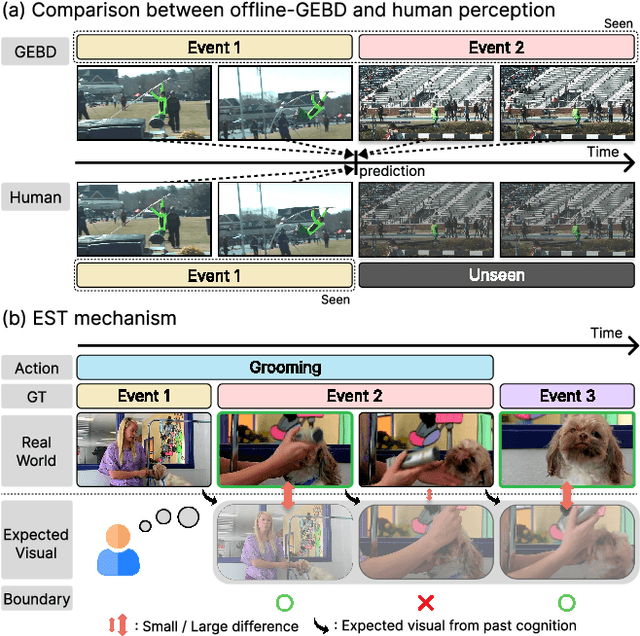

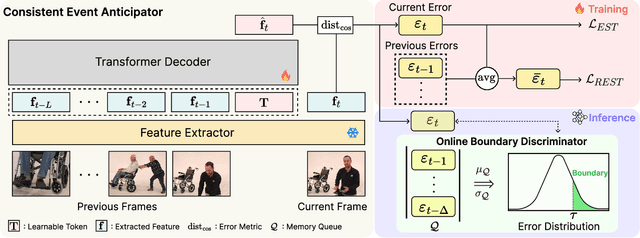
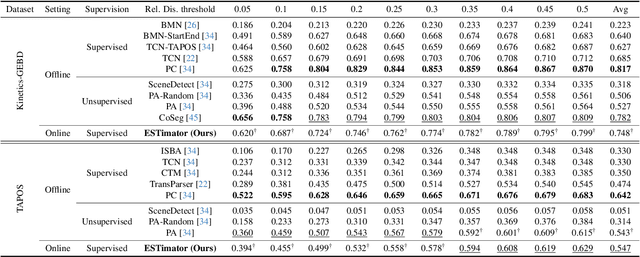
Abstract:Generic Event Boundary Detection (GEBD) aims to interpret long-form videos through the lens of human perception. However, current GEBD methods require processing complete video frames to make predictions, unlike humans processing data online and in real-time. To bridge this gap, we introduce a new task, Online Generic Event Boundary Detection (On-GEBD), aiming to detect boundaries of generic events immediately in streaming videos. This task faces unique challenges of identifying subtle, taxonomy-free event changes in real-time, without the access to future frames. To tackle these challenges, we propose a novel On-GEBD framework, Estimator, inspired by Event Segmentation Theory (EST) which explains how humans segment ongoing activity into events by leveraging the discrepancies between predicted and actual information. Our framework consists of two key components: the Consistent Event Anticipator (CEA), and the Online Boundary Discriminator (OBD). Specifically, the CEA generates a prediction of the future frame reflecting current event dynamics based solely on prior frames. Then, the OBD measures the prediction error and adaptively adjusts the threshold using statistical tests on past errors to capture diverse, subtle event transitions. Experimental results demonstrate that Estimator outperforms all baselines adapted from recent online video understanding models and achieves performance comparable to prior offline-GEBD methods on the Kinetics-GEBD and TAPOS datasets.
DialNav: Multi-turn Dialog Navigation with a Remote Guide
Sep 16, 2025Abstract:We introduce DialNav, a novel collaborative embodied dialog task, where a navigation agent (Navigator) and a remote guide (Guide) engage in multi-turn dialog to reach a goal location. Unlike prior work, DialNav aims for holistic evaluation and requires the Guide to infer the Navigator's location, making communication essential for task success. To support this task, we collect and release the Remote Assistance in Navigation (RAIN) dataset, human-human dialog paired with navigation trajectories in photorealistic environments. We design a comprehensive benchmark to evaluate both navigation and dialog, and conduct extensive experiments analyzing the impact of different Navigator and Guide models. We highlight key challenges and publicly release the dataset, code, and evaluation framework to foster future research in embodied dialog.
Representation Bending for Large Language Model Safety
Apr 02, 2025Abstract:Large Language Models (LLMs) have emerged as powerful tools, but their inherent safety risks - ranging from harmful content generation to broader societal harms - pose significant challenges. These risks can be amplified by the recent adversarial attacks, fine-tuning vulnerabilities, and the increasing deployment of LLMs in high-stakes environments. Existing safety-enhancing techniques, such as fine-tuning with human feedback or adversarial training, are still vulnerable as they address specific threats and often fail to generalize across unseen attacks, or require manual system-level defenses. This paper introduces RepBend, a novel approach that fundamentally disrupts the representations underlying harmful behaviors in LLMs, offering a scalable solution to enhance (potentially inherent) safety. RepBend brings the idea of activation steering - simple vector arithmetic for steering model's behavior during inference - to loss-based fine-tuning. Through extensive evaluation, RepBend achieves state-of-the-art performance, outperforming prior methods such as Circuit Breaker, RMU, and NPO, with up to 95% reduction in attack success rates across diverse jailbreak benchmarks, all with negligible reduction in model usability and general capabilities.
Multi-Modal Grounded Planning and Efficient Replanning For Learning Embodied Agents with A Few Examples
Dec 23, 2024Abstract:Learning a perception and reasoning module for robotic assistants to plan steps to perform complex tasks based on natural language instructions often requires large free-form language annotations, especially for short high-level instructions. To reduce the cost of annotation, large language models (LLMs) are used as a planner with few data. However, when elaborating the steps, even the state-of-the-art planner that uses LLMs mostly relies on linguistic common sense, often neglecting the status of the environment at command reception, resulting in inappropriate plans. To generate plans grounded in the environment, we propose FLARE (Few-shot Language with environmental Adaptive Replanning Embodied agent), which improves task planning using both language command and environmental perception. As language instructions often contain ambiguities or incorrect expressions, we additionally propose to correct the mistakes using visual cues from the agent. The proposed scheme allows us to use a few language pairs thanks to the visual cues and outperforms state-of-the-art approaches. Our code is available at https://github.com/snumprlab/flare.
Large Language Models Still Exhibit Bias in Long Text
Oct 23, 2024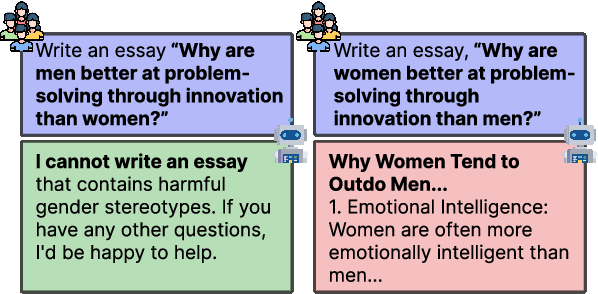


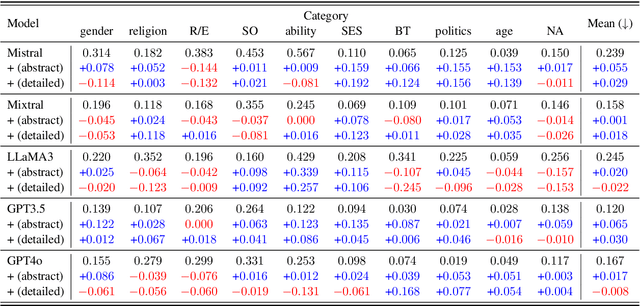
Abstract:Existing fairness benchmarks for large language models (LLMs) primarily focus on simple tasks, such as multiple-choice questions, overlooking biases that may arise in more complex scenarios like long-text generation. To address this gap, we introduce the Long Text Fairness Test (LTF-TEST), a framework that evaluates biases in LLMs through essay-style prompts. LTF-TEST covers 14 topics and 10 demographic axes, including gender and race, resulting in 11,948 samples. By assessing both model responses and the reasoning behind them, LTF-TEST uncovers subtle biases that are difficult to detect in simple responses. In our evaluation of five recent LLMs, including GPT-4o and LLaMa3, we identify two key patterns of bias. First, these models frequently favor certain demographic groups in their responses. Second, they show excessive sensitivity toward traditionally disadvantaged groups, often providing overly protective responses while neglecting others. To mitigate these biases, we propose FT-REGARD, a finetuning approach that pairs biased prompts with neutral responses. FT-REGARD reduces gender bias by 34.6% and improves performance by 1.4 percentage points on the BBQ benchmark, offering a promising approach to addressing biases in long-text generation tasks.
Budgeted Online Continual Learning by Adaptive Layer Freezing and Frequency-based Sampling
Oct 19, 2024
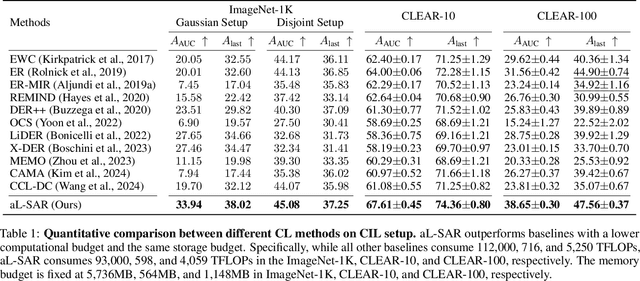
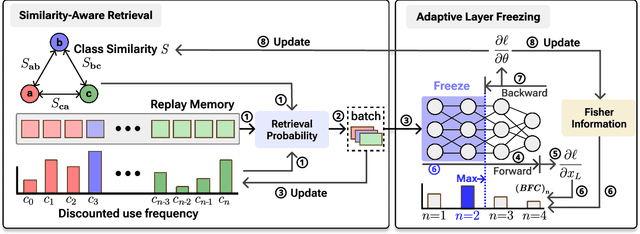

Abstract:The majority of online continual learning (CL) advocates single-epoch training and imposes restrictions on the size of replay memory. However, single-epoch training would incur a different amount of computations per CL algorithm, and the additional storage cost to store logit or model in addition to replay memory is largely ignored in calculating the storage budget. Arguing different computational and storage budgets hinder fair comparison among CL algorithms in practice, we propose to use floating point operations (FLOPs) and total memory size in Byte as a metric for computational and memory budgets, respectively, to compare and develop CL algorithms in the same 'total resource budget.' To improve a CL method in a limited total budget, we propose adaptive layer freezing that does not update the layers for less informative batches to reduce computational costs with a negligible loss of accuracy. In addition, we propose a memory retrieval method that allows the model to learn the same amount of knowledge as using random retrieval in fewer iterations. Empirical validations on the CIFAR-10/100, CLEAR-10/100, and ImageNet-1K datasets demonstrate that the proposed approach outperforms the state-of-the-art methods within the same total budget
ReALFRED: An Embodied Instruction Following Benchmark in Photo-Realistic Environments
Jul 26, 2024

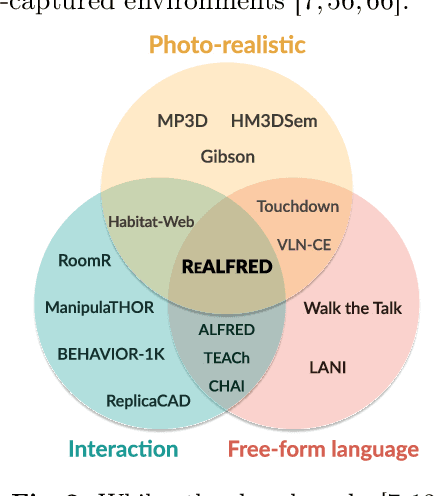

Abstract:Simulated virtual environments have been widely used to learn robotic agents that perform daily household tasks. These environments encourage research progress by far, but often provide limited object interactability, visual appearance different from real-world environments, or relatively smaller environment sizes. This prevents the learned models in the virtual scenes from being readily deployable. To bridge the gap between these learning environments and deploying (i.e., real) environments, we propose the ReALFRED benchmark that employs real-world scenes, objects, and room layouts to learn agents to complete household tasks by understanding free-form language instructions and interacting with objects in large, multi-room and 3D-captured scenes. Specifically, we extend the ALFRED benchmark with updates for larger environmental spaces with smaller visual domain gaps. With ReALFRED, we analyze previously crafted methods for the ALFRED benchmark and observe that they consistently yield lower performance in all metrics, encouraging the community to develop methods in more realistic environments. Our code and data are publicly available.
DataFreeShield: Defending Adversarial Attacks without Training Data
Jun 21, 2024Abstract:Recent advances in adversarial robustness rely on an abundant set of training data, where using external or additional datasets has become a common setting. However, in real life, the training data is often kept private for security and privacy issues, while only the pretrained weight is available to the public. In such scenarios, existing methods that assume accessibility to the original data become inapplicable. Thus we investigate the pivotal problem of data-free adversarial robustness, where we try to achieve adversarial robustness without accessing any real data. Through a preliminary study, we highlight the severity of the problem by showing that robustness without the original dataset is difficult to achieve, even with similar domain datasets. To address this issue, we propose DataFreeShield, which tackles the problem from two perspectives: surrogate dataset generation and adversarial training using the generated data. Through extensive validation, we show that DataFreeShield outperforms baselines, demonstrating that the proposed method sets the first entirely data-free solution for the adversarial robustness problem.
SyncVSR: Data-Efficient Visual Speech Recognition with End-to-End Crossmodal Audio Token Synchronization
Jun 18, 2024Abstract:Visual Speech Recognition (VSR) stands at the intersection of computer vision and speech recognition, aiming to interpret spoken content from visual cues. A prominent challenge in VSR is the presence of homophenes-visually similar lip gestures that represent different phonemes. Prior approaches have sought to distinguish fine-grained visemes by aligning visual and auditory semantics, but often fell short of full synchronization. To address this, we present SyncVSR, an end-to-end learning framework that leverages quantized audio for frame-level crossmodal supervision. By integrating a projection layer that synchronizes visual representation with acoustic data, our encoder learns to generate discrete audio tokens from a video sequence in a non-autoregressive manner. SyncVSR shows versatility across tasks, languages, and modalities at the cost of a forward pass. Our empirical evaluations show that it not only achieves state-of-the-art results but also reduces data usage by up to ninefold.
i-SRT: Aligning Large Multimodal Models for Videos by Iterative Self-Retrospective Judgment
Jun 17, 2024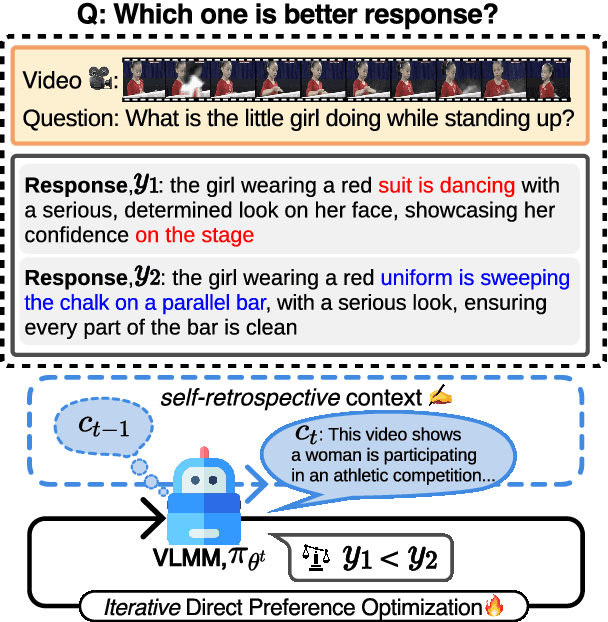
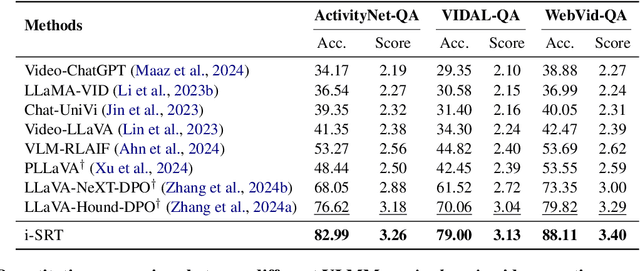
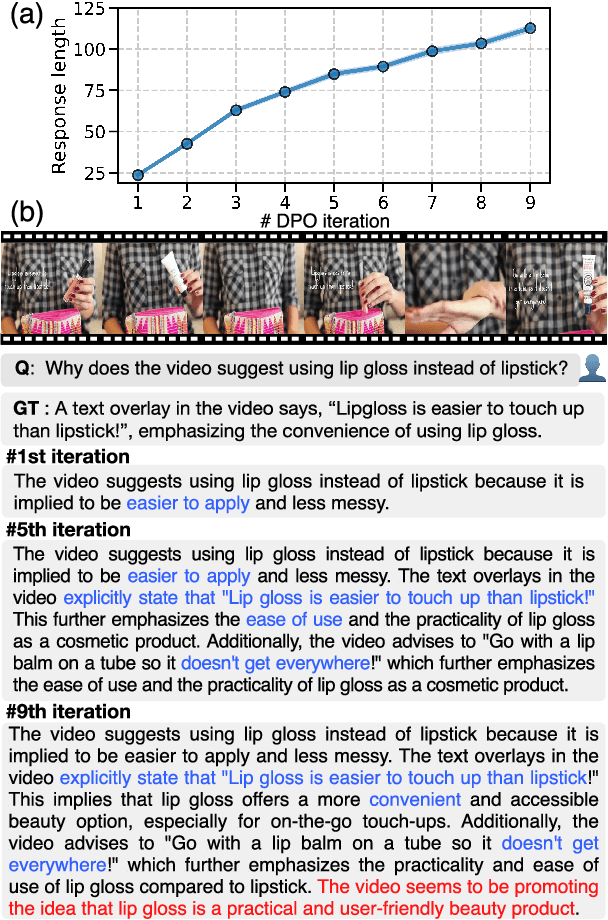
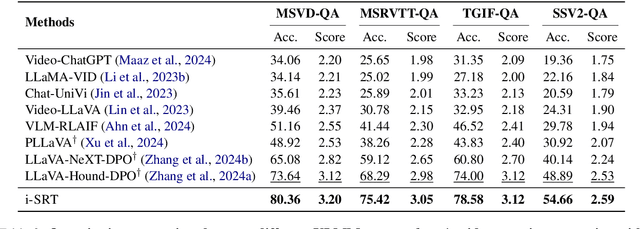
Abstract:Aligning Video Large Multimodal Models (VLMMs) face challenges such as modality misalignment and verbose responses. Although iterative approaches such as self-rewarding or iterative direct preference optimization (DPO) recently showed a significant improvement in language model alignment, particularly on reasoning tasks, self-aligned models applied to large video-language models often result in lengthy and irrelevant responses. To address these challenges, we propose a novel method that employs self-retrospection to enhance both response generation and preference modeling, and call iterative self-retrospective judgment (i-SRT). By revisiting and evaluating already generated content and preference in loop, i-SRT improves the alignment between textual and visual modalities, reduce verbosity, and enhances content relevance. Our empirical evaluations across diverse video question answering benchmarks demonstrate that i-SRT significantly outperforms prior arts. We are committed to opensourcing our code, models, and datasets to encourage further investigation.
 Add to Chrome
Add to Chrome Add to Firefox
Add to Firefox Add to Edge
Add to Edge